
Isopoda is an order of crustaceans that includes woodlice and their relatives. Isopods live in the sea, in fresh water, or on land. All have rigid, segmented exoskeletons, two pairs of antennae, seven pairs of jointed limbs on the thorax, and five pairs of branching appendages on the abdomen that are used in respiration. Females brood their young in a pouch under their thorax.
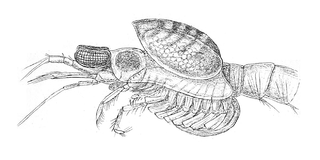
Epicaridea is a former suborder of isopods, now treated as part of the infraorder Cymothoida. They are ectoparasites that inhabit other crustaceans, namely ostracods, copepods, barnacles and malacostracans. The suborder is found globally. Epicaridea are generally less well researched than other isopods.

Iais pubescens is a species of marine isopod in the family Janiroidea. It inhabits seashores in a large number of locations in the southern hemisphere and may be found both free-living, and as commensals on larger isopods.

In zoology, deep-sea gigantism is the tendency for species of invertebrates and other deep-sea dwelling animals to be larger than their shallower-water relatives across a large taxonomic range. Proposed explanations for this type of gigantism include colder temperature, food scarcity, reduced predation pressure and increased dissolved oxygen concentrations in the deep sea. The inaccessibility of abyssal habitats has hindered the study of this topic.
The Microcerberidea are a suborder of isopod crustaceans. They are less than 2 mm (0.079 in) long, and live interstitially. They may be found in the eastern Pacific Ocean, and around the coasts of South America, Africa, the Mediterranean Sea, and India.
The Microcerberidae are a family of isopod crustaceans. They are less than 2 mm (0.079 in) long, and live interstitially in shallow marine or freshwater sand habitats.

Clinus acuminatus, the sad klipfish, is a species of fish in the family Clinidae. It is endemic to Southern Africa, where it occurs along the coast of Namibia and South Africa. It can reach a maximum length of 13 centimetres (5.1 in) TL and is viviparous. The sad klipfish feeds on crustaceans.

Gibbonsia elegans, the spotted kelpfish, is a species of clinid native to subtropical waters of the Pacific Ocean from central California, U.S. to southern Baja California, Mexico. It prefers subtidal rocky habitats with seaweed down to a depth of about 56 metres (184 ft). This species can reach a maximum length of 16 centimetres (6.3 in) TL. This species feeds on benthic crustaceans, gastropods, and polychaete worms. Gibbonsia is named after Dr. William P. Gibbsons who was a naturalist in the California Academy of Science. It is found in three different colors depending on their habitat. Males and females do not show sexual dimorphism.
Hemioniscus balani, a species of isopod crustacean, is a widespread parasitic castrator of barnacle in the northern Atlantic Ocean. Its range extends from Norway to the Atlantic coast of France, and as far west as Massachusetts. It is also commonly found on the Pacific coast of North America; it is not known if the Pacific and Atlantic populations are the same species, or if the Pacific population exists following human-assisted introduction.
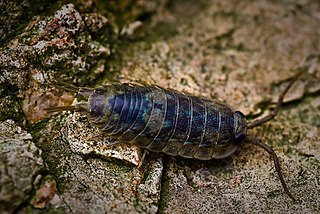
Ligia is a genus of isopods, commonly known as rock lice or sea slaters. Most Ligia species live in tidal zone cliffs and rocky beaches, but there are several fully terrestrial species occur in high-humidity environments.
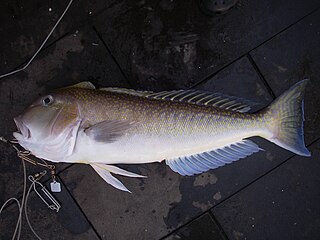
The great northern tilefish or golden tile, is the largest species in the family Malacanthidae (tilefishes), which grows to an average length between 38 to 44 inches. The great northern tilefish is a slow-growing and long-lived species, which has four stages of life. After hatching from eggs, the larvae are found in plankton. As they grow into juveniles, the individuals seek shelter until finding or making their own burrows. As adults, the tilefish continue to expand their burrows in the sediment throughout their lives. The diet of the larvae is unknown, but presumed to consist of zooplankton; juveniles and adults feed upon various benthic invertebrates, crustaceans, and fish. After reaching sexual maturity between 5 and 7 years of age, females lay eggs throughout the mating season for the male to fertilize, with each female laying an average of 2.3 million eggs.

Anilocra capensis is a species of parasitic isopod in the family Cymothoidae. It is endemic to southern Africa. The species preferentially attaches itself to the hottentot seabream.

Pachymetopon blochii, the hottentot seabream or hottentot, is a species of sea bream in the family Sparidae, native to the southwestern coast of Africa.

Glyptidotea is a monotypic genus of isopod in the family Idoteidae. Its sole member is Glyptidotea lichtensteini, the keeled isopod, a medium-sized isopod found on the coast of southern Africa.

Exosphaeroma laeviusculum is a species of isopod in the family Sphaeromatidae, native to the west coast of southern Africa.
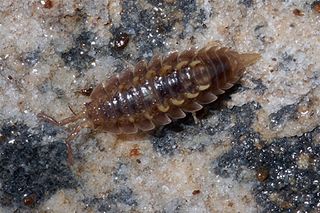
Deto is a genus of woodlice in the family Detonidae. Members of this genus can be found along the coasts in areas of New Zealand, Namibia, South Africa and Australia.
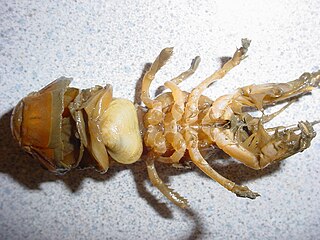
Neaeromya rugifera is a species of bivalve that inhabits the West Coast of North America.

Opisthoteuthis agassizii is a lesser-known, deep-sea octopus first described in 1883 by Addison E. Verrill.
Allodiplophryxus floridanu is an isopoda parasite present in the waters of the Gulf of Mexico.

Notothenia cyanobrancha, the blue rockcod, bluegillnotothen, or bluegill rockcod, is a species of marine ray-finned fish, belonging to the family Nototheniidae, the notothens or cod icefishes. It is native to the Kerguelen and Heard Islands in the Southern Ocean.
















